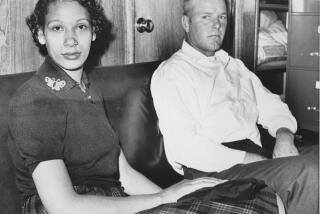Wife Recalls Victory in Battle to Overturn Ban on Interracial Marriage : Law: Black woman wed to white says of case taken to Supreme Court: ‘That’s why we were put here.’
- Share via
SPARTA, Va. — On a warm night when she was a new bride of 17, Mildred Loving awoke in terror to a sheriff standing over her bed. Her crime? She was a black woman married to a white man.
That night marked the beginning of a legal battle that led to the Supreme Court’s rejection 25 years ago of all laws forbidding interracial marriage.
“I believe that’s why we were put here,” Mildred Loving said softly. “That’s why we were married.”
But in 1958, Mildred Jeter and Richard Loving were simply a young couple in love who wanted to become husband and wife. “I didn’t know it was against any law. We were just happy to be together,” she said.
Her husband-to-be may have known about Virginia’s anti-miscegenation, or race-mixing, law, but he said nothing. She didn’t ask him why they traveled 80 miles from Caroline County to Washington, D.C., to marry.
“We weren’t out to change nothing,” she said.
But the marriage of the pretty, slim woman and the shy, gangly bricklayer changed everything. It put them in jail. It forced them to leave the hilly countryside near some of the storied battlefields of a war over race fought a century before. And, in 1967, it resulted in a ruling that overturned one of the last legal struts to racism and segregation in Virginia and 15 other states.
“It was taken for granted before 1954 and never questioned,” said Erwin Griswold, former dean of Harvard University Law School and U.S. solicitor general from 1967 to 1973. “It was all part of the Jim Crow pattern in force throughout the South.”
The prosecutor, who did not take part in the case, said the law served the same public interests as those barring polygamy and incest.
“It seemed to me and others who were then working before the Supreme Court that it was a natural and inevitable development,” Griswold said.
Mildred Loving is alone now; the marriage that entered her name in law school textbooks ended in 1975 when a drunk driver broadsided the couple’s car, killing her husband.
She lives quietly in the small cinder-block house Richard Loving built for his wife and three children after the Supreme Court decision allowed them to return to Virginia.
At 52, Mildred Loving is hobbled by arthritis and rarely ventures more than a few miles from the tiny town where she and Richard grew up. She thinks of the case only rarely, and it is rarer still that anyone mentions it to her. Her grandchildren have heard the story hundreds of times, but she’s not sure they can really understand it.
“It’s history,” she said. “It’s all different now from how it was then.”
Then, the Lovings were the only black-white married couple they knew. Now, there are about 231,000 such couples in the United States, according to Census data.
In rural Caroline County in the 1950s, blacks and whites socialized frequently, although schools and churches were strictly segregated.
Mildred Loving knew her husband from childhood. Richard Loving began courting her when she was 11 and he would come to her family’s farmhouse to hear her seven brothers play “hillbilly music.”
No one in their tight-knit community gave them any trouble or voiced objections to their plans to marry, Mrs. Loving said.
“But we had one enemy, I guess,” she said.
That anonymous enemy was the person who called authorities a month after the wedding. Three officers came to the house and woke the couple at 2 a.m.
“I was scared to death,” Mildred Loving said.
With the flood of a flashlight full on their faces, the officers demanded that Richard Loving identify the woman lying beside him.
“At first, he didn’t say anything. So I spoke up. I said I was his wife,” Mrs. Loving said.
They were charged under the 1922 anti-miscegenation law that stated: “If any white person intermarry with a colored person, or any colored person intermarry with a white person, he shall be guilty of a felony.” Punishment was one to five years in prison.
“It does seem incredible now,” said Bernard Cohen, who was a 33-year-old lawyer just starting his practice when he took the Lovings’ case for free in 1964.
That was long after Mildred and Richard Loving were convicted and sentenced to a year in prison.
The judge suspended the sentence on the condition the couple leave the state, but told them: “Almighty God created the races white, black, yellow, Malay and red, and he placed them on separate continents. And but for the interference with his arrangement there would be no cause for such marriages. The fact that he separated the races showed that he did not intend for the races to mix.”
The Lovings spent several unhappy years in a cramped apartment in Washington, unable to travel to Virginia together for visits.
In 1964, Mildred Loving wrote to Atty. Gen. Robert Kennedy, asking if the just-passed Civil Rights Act would help them return home. She received a personal reply. No, Kennedy wrote, the law would not apply. But he urged her to contact the American Civil Liberties Union.
The Lovings were afraid to cross the Potomac River to Cohen’s office in Alexandria, Va., so they met at the ACLU office in Washington.
“I couldn’t believe it,” Cohen said. “I knew it was going to be a landmark case. I knew it was going to the Supreme Court. And I definitely thought there was something serendipitous about the fact that the case would be called Loving vs. the Commonwealth of Virginia.”
Cohen sued Virginia under an obscure law that allowed him to challenge the Lovings’ conviction even though they had never appealed.
The case bounced back and forth between state and federal courts for several years, before the Virginia Supreme Court ruled the law valid.
Before arguing the case before the U.S. Supreme Court, Cohen said he tried to explain to Richard Loving the legal doctrines he would use.
“He was very country, sort of rough,” Cohen said. “He just said, ‘Tell them I don’t understand why if a man loves a woman he can’t marry her no matter what her color.’ ”
More to Read
Sign up for Essential California
The most important California stories and recommendations in your inbox every morning.
You may occasionally receive promotional content from the Los Angeles Times.













